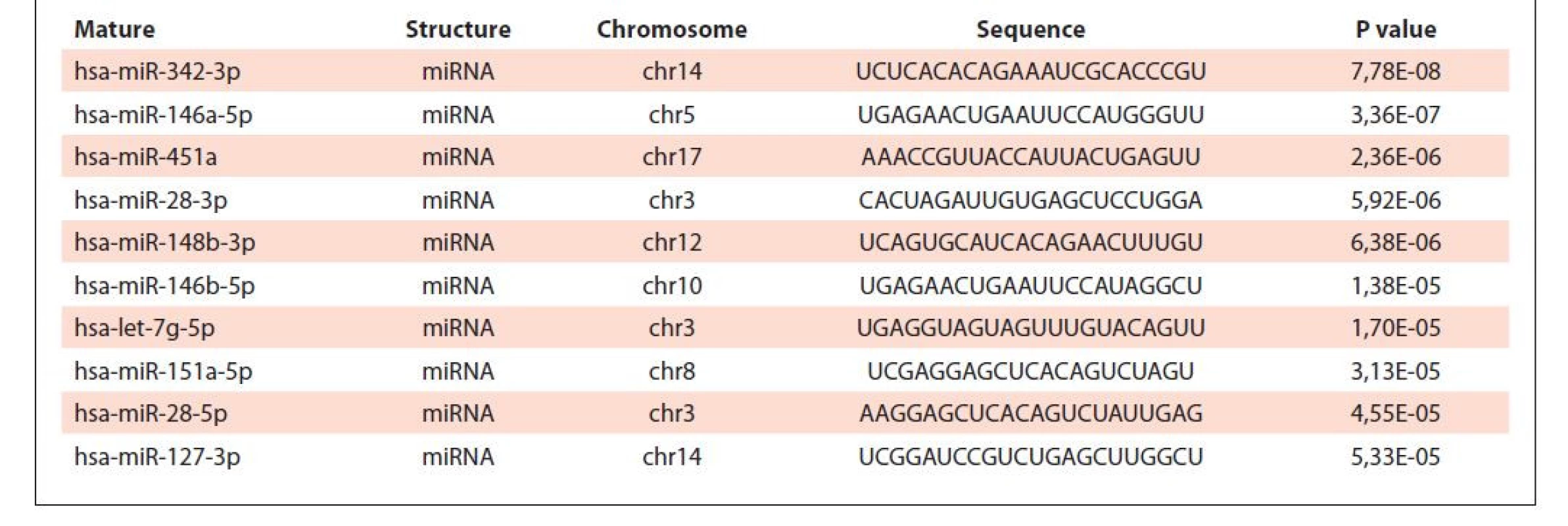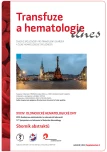-
Články
Top novinky
Reklama- Vzdělávání
- Časopisy
Top články
Nové číslo
- Témata
Top novinky
Reklama- Kongresy
- Videa
- Podcasty
Nové podcasty
Reklama- Kariéra
Doporučené pozice
Reklama- Praxe
Top novinky
ReklamaPOSTEROVÁ SEKCE
Published in the journal: Transfuze Hematol. dnes,28, 2022, No. Supplementum 2, p. 54-72.
P03. IMPACT OF TP53 AND ATM ABERRATIONS ON THE CLINICAL COURSE OF CLL PATIENTS ON NOVEL AGENTS – SINGLE CENTER STUDY
Kašková V.1, Petráčková A.1, Kubová Z.2, Turcsanyi P.2, Maňáková J.1, Ryznerová P.2, Urbánková H.2, Papajík T.2, Kriegová E.1
1Department of Immunology, Faculty of Medicine and Dentistry, Palacky University and University Hospital, Olomouc
2Department of Hemato-Oncology, Faculty of Medicine and Dentistry, Palacky University and University Hospital, Olomouc
Background: TP53 and ATM aberrations (mutations and/or deletions) are the most important predictive/prognostic markers in chronic lymphocytic leukemia (CLL). The prognostic value of carrying isolated (single-hit) or multiple (multi-hit) TP53 and ATM aberrations remains unclear, especially in the context of treatment with novel agents.
Methods: The study cohort consisted of 109 patients with CLL (males/females, 68/41; median age 67.0 years) treated with ibrutinib (N = 83) or idelalisib (N = 26), of them 82.6% (90) with unmutated IgVH. Targeted deep next-generation sequencing (NGS) was used to detect the mutations of TP53/ATM genes in peripheral blood samples, fluorescence in situ hybridization to detect deletions (del) (11q) and del (17p). Progression-free survival (PFS) was estimated by the Kaplan-Meier method and compared between subgroups by the log-rank test.
Results: In our real-world cohort of patients treated with novel agents, 59 patients had TP53 aberration (32 had TP53 aberration only, 27 had TP53 aberration with concomitant ATM aberration), 21 had ATM aberration only, and 29 had no TP53/ATM aberration. Regarding TP53 aberrations, 35 (32.1%) patients carried a single-hit TP53 aberration (mutations/deletions 30/5) and 24 (22.0%) patients carried a multi-hit TP53 aberration. Regarding ATM aberrations, 29 (26.6%) patients carried single-hit ATM aberrations (mutations/deletions 6/23) and 19 (17.4%) patients carried multi-hit ATM aberrations. Of the TP53 and ATM mutations detected, 50.9% were subclonal (median variant allele frequency 9%, min–max 1–93%). The most significant effect on PFS was seen in patients carrying TP53 aberrations compared to patients with no TP53/ATM aberration (median PFS 25 vs. 68 months; P = 0.009); no difference was observed between patients with single-hit and multi-hit TP53 (P > 0.05). When evaluating ATM aberrations, we observed a trend towards shorter PFS in patients with multi-hit ATM (P = 0.080), but not in patients with single-hit ATM aberration. Six patients with concurrent multi-hit TP53/multi-hit ATM aberrations had very short PFS on ibrutinib/idelalisib (9 months).
Conclusions: In this study, the most significant impact on PFS was evident in patients treated with novel agents carrying the TP53 aberrations, with no difference between patients with single-hit and multi-hit TP53. There was also a trend to shorter PFS in patients with multi-hit ATM. These results highlight the single-hit TP53 and multi-hit ATM aberrations as prognostic factors in patients CLL treated with novel agents.
Support by grant IGA_LF_2022_011, CZ.02.2.69/0.0/0.0/19_073/0016713, and MH CZ-DRO (FNOL, 00098892).
P10. B-CELL NON-HODGKIN‘S LYMPHOMAS ASSOCIATED WITH AMYLOIDOSIS
Navrátilová M.1, Flodrová P.1, Holub D.2, Pika T.3, Džubák P.2,Flodr P.1
1 Department of Clinical and Molecular Pathology, Faculty of Medicine Palacky University and University Hospital Olomouc
2 Department of Molecular and Translational Medicine, Faculty of Medicine Palacky University Olomouc
3 Department of Hemato-Oncology, University Hospital Olomouc
Introduciton: Different types of B-cell non-Hodgkin‘s lymphomas (MZL, LPL, B-CLL/SLL, FL, MCL, DLBCL) may show plasmacytic differentiation and may produce AL amyloid locally or as a part of systemic amyloidosis with the deposition of insoluble amyloid in the extracellular tissue spaces leading to the organ damage. Case reports of coincidence of B-NHL and non-AL amyloidosis (e. g. AA, ATTR) were also reported. Therefore correct diagnostic workflow to type amyloid deposits should include three main steps 1. special histological staining (Congo red and/or Saturn red), 2. immunoprofiling (limited set of IF a IHC antibodies) and proteomic analysis (LMD-LC/MS). Amyloidosis is a heterogeneous acquired or hereditary disease that results from the abnormal and insoluble deposition of beta-sheet fibrillar protein aggregates in various tissues with variable distribution in extracellular space. Nomenclature classification distinguishes 36 amyloidogenic proteins and more are expected (ISA 2020).
Methods: Amyloid deposits were detected in variable FFPE tissues and organs stained with Congo red and/or Saturn red with consequent immunohistochemical analysis (IHC), and part of the file was also analysed by proteomic analysis with the use of laser capture microdissection and liquid chromatography/tandem mass spectrometry (LMD-LC/MS/MS). Concurent B-NHLs (excl. multiple myeloma, plasmocytoma and MGUS) were diagnosed due to characteristic morphology (HE, PAS, Giemsa), immunoprofile (primary antibodies with appropriate dilution – CD3, CD5, CD10, CD20, CD21, CD23, CD30, CD138, Bcl-2, Bcl-6, MUM1/IRF4, PAX5, cyclin D1 and/or SOX11, c-Myc, Ki67) and detected clonal rearrangement of IgVH (PCR, BIOMED-2).
Results: In our file with 329 amyloid positive specimens concurent B-NHLs (excl. multiple myeloma, plasmocytoma and MGUS) were found in 14 specimens. seven specimens were signed as highly suspected for B-NHL with plasmacytic differentiation and immunoglobulin light chain restriction (IHC) but without evidence of IgVH clonal rearrangement (PCR RFLP). The most common B-NHL associated with localised amyloidosis was ENMZL MALT-type (10 cases, one case with hybrid amyloidosis AL kappa/AH IgG1), in four specimens LPL was detected. In all cases with IHC and/or LCM-LC/tandem MS analysis AL type of amyloid was detected including two cases with hybrid amyloidosis AL/AH and AL/AApoAIV, and in one case local AL amyloid deposition was produced after a therapy for B-NHL.
Conclusion: Analysis of amyloid deposits irrespective of origin and localization is appealing for diagnostic and experimental precising which brings new insights not only particular pathogenesis but also in classification nomenclature, and correct therapy due to a possibilty of combination of amyloid deposits or hybrid amyloid deposits in variable topography and in time evolution, and also concurrent B-NHL may be detected. Detected M-protein produced by B-NHL may be low or high according to a localised or systemic AL involvement resp., localised amyloid deposition is commonly associated with ENMZL MALT-type, both localised and systemic amyloidosis may be found out in LPL. Current variant of mantle cell lymphoma SOX11-negative, cyclin D1 positive with CCND1 translocation and IGH hypermutated was established with developed plasmacytic differentiation, localised amyloid deposition and indolent biologic behavior. Our category of highly suspected B-NHL with plasmacytic differentiation is literary sign as „AL amyloidosis with a localized B-cell neoplasia of undetermined significance“ or as „AL amyloidosis with a an associated predominant kappa or lambda light chain expressing plasma cell population without evidence for clonality“. In our file (seven cases) only kappa/lambda immunohistochemically detected monotypy was recorded without an evidence of IgVH clonal rearrangement (somatic hypermutation of IgVH may be expected). Treatment recommendations for B-NHL-related amyloidosis entities are based only on retrospective or small prospective trials of single centers. The possibility of senescence evolution in B-NHL after a therapy may also bring local AL deposits (one case in our cohort). Coincidence or association of non-AL amyloidosis (ATTRwt, ATTRv, AA and another) with B-NHL was described mainly in single case reports and extends the differential diagnosis. In a such cases both methods (IHC and LCM-LC/tandem MS) are suitable for correct amyloid typing, although LMD-LC/tandem MS brought more promising results than IHC.
Supported by AZV-16-31156A, NU22-08-00306 and LF_2022_004 from Palacky University Olomouc.
P27. MPS ANALYSIS OF MIRNA IN PATIENTS WITH BCR-ABL1 FUSION GENE
Řehounková M.1, Kovaříková H.1, Růžičková B.1, Žák P.2, Palička V.1, Gančarčíková M.1
1 Department of Clinical Biochemistry and Diagnostics, Faculty of Medicine and University Hospital Hradec Králové
2 IV. Department of Internal Hematology, University Hospital Hradec Králové
Changes in the regulation of genetic expression by small RNA molecules have been demonstrated in many cancers, including hematological malignancies as CML. The method of massive parallel sequencing (MPS) of the overall set of patient’s miRNA (miRNome) is advantageous due to high resolution of MPS and its feasibility with a small amount sample. MPS provides a large amount of quality data, which opens up the possibility of discovering new miRNAs and their relationship to the course of CML and the response to treatment with available kinase inhibitors (TKI).
Tested group included 20 samples from patients with a proven BCR-ABL1 fusion gene, who did not reach MMR4 after one year of TKI treatment or relapsed. As a control group, 7 patients were chosen with a proven BCR-ABL1 fusion gene and achievement of MMR4.5 response. First, miRNA isolation was performed using the miRNeasy Mini Kit (Qiagen), library itself was prepared using a RealSeq®-AC kit (Somagenics) and sequenced on a MiSeq instrument (Illumina). The data received has been submitted to the processing by bioinformatical pipeline to verify the quality of the data. The analysis of the obtained miRNA sequences was performed using the online tool OASIS 2.0 (BONN LABORATORY). Analysis using this online program included not only the identification of possible new miRNAs and a comprehensive view of the miRNom, but also helped with statistical processing.
Tab. 1. miRNA with highly-signifi cant diff erence of expression among tested groups. 
In the studies of 27 samples, the following miRNAs were found to be the most expressed: hsa-miR-233-3p, hsa-miR-451a, hsa-miR-21-5p, hsa-miR-16-5p, p-hsa-miR-247, hsa-miR-142-3p, hsa-let-7a-5p, hsa-miR-92a-3p and hsa-miR-191-5p. Differential analysis of the test and control group showed very significant differences (P ≤ 0,01) in the expressions of 75 miRNA and highly significant differences (P ≤ 0.001) in the expressions of 38 miRNAs. The 10 miRNA with the most significant difference in expression between our study groups are shown in Tab. 1.
Comparation of the processed data with recent publications shows the connection of individual miRNAs with hematological malignancies: eg miR-146a as a prognostic marker in ALL, downregulation of miR-146b-5p in CLL, downregulation miR-451 in CML phenotype, etc. The obtained data correlate with the expected results, but for more accurate conclusions, statistical analyses and possible use of miRNAs as prognostic markers, it would be appropriate to expand the group of patients.
This study was supported by MH CZ – DRO (UHHK, 00179906).
Štítky
Hematologie a transfuzní lékařství Interní lékařství Onkologie
Článek 2. WIEDERMANNOVA PŘEDNÁŠKAČlánek 3. POSTGRADUÁLNÍ SEKCE 2Článek 4. MALIGNÍ LYMFOMYČlánek 5. MONOKLONÁLNÍ GAMAPATIEČlánek 6. AKUTNÍ LEUKÉMIEČlánek 1. POSTGRADUÁLNÍ SEKCE 1
Článek vyšel v časopiseTransfuze a hematologie dnes
Nejčtenější tento týden
2022 Číslo Supplementum 2- Není statin jako statin aneb praktický přehled rozdílů jednotlivých molekul
- Biomarker NT-proBNP má v praxi široké využití. Usnadněte si jeho vyšetření POCT analyzátorem Afias 1
- S MUDr. Petrou Vysočanovou o hypertenzi u diabetiků: Jak léčit skutečně účinně a bez zbytečných rizik?
- Moje zkušenosti s Magnosolvem podávaným pacientům jako profylaxe migrény a u pacientů s diagnostikovanou spazmofilní tetanií i při normomagnezémii - MUDr. Dana Pecharová, neurolog
- Antikoagulační léčba u pacientů před operačními výkony
-
Všechny články tohoto čísla
- 2. WIEDERMANNOVA PŘEDNÁŠKA
- 3. POSTGRADUÁLNÍ SEKCE 2
- 4. MALIGNÍ LYMFOMY
- 5. MONOKLONÁLNÍ GAMAPATIE
- 6. AKUTNÍ LEUKÉMIE
- 7. MYELOIDNÍ NEOPLÁZIE A VZÁCNÁ ONEMOCNĚNÍ
- 8. TRANSPLANTACE A BUNĚČNÁ TERAPIE
- 9. CYTOMORFOLOGIE V HEMATOLOGII
- 10. HEMATOLOGIE A TRANSFUZE DNES
- 11. CHRONICKÁ LYMFOCYTÁRNÍ LEUKÉMIE
- 12. MYELOPROLIFERATIVNÍ NEMOCI A CHRONICKÁ MYELOIDNÍ LEUKÉMIE
- 1. POSTGRADUÁLNÍ SEKCE 1
- 13TH SYMPOSIUM ON ADVANCES IN MOLECULAR HEMATOLOGY
- POSTEROVÁ SEKCE
- Transfuze a hematologie dnes
- Archiv čísel
- Aktuální číslo
- Pouze online
- Informace o časopisu
Nejčtenější v tomto čísle- 10. HEMATOLOGIE A TRANSFUZE DNES
- 6. AKUTNÍ LEUKÉMIE
- POSTEROVÁ SEKCE
- 12. MYELOPROLIFERATIVNÍ NEMOCI A CHRONICKÁ MYELOIDNÍ LEUKÉMIE
Kurzy
Zvyšte si kvalifikaci online z pohodlí domova
Autoři: prof. MUDr. Vladimír Palička, CSc., Dr.h.c., doc. MUDr. Václav Vyskočil, Ph.D., MUDr. Petr Kasalický, CSc., MUDr. Jan Rosa, Ing. Pavel Havlík, Ing. Jan Adam, Hana Hejnová, DiS., Jana Křenková
Autoři: MUDr. Irena Krčmová, CSc.
Autoři: MDDr. Eleonóra Ivančová, PhD., MHA
Autoři: prof. MUDr. Eva Kubala Havrdová, DrSc.
Všechny kurzyPřihlášení#ADS_BOTTOM_SCRIPTS#Zapomenuté hesloZadejte e-mailovou adresu, se kterou jste vytvářel(a) účet, budou Vám na ni zaslány informace k nastavení nového hesla.
- Vzdělávání



